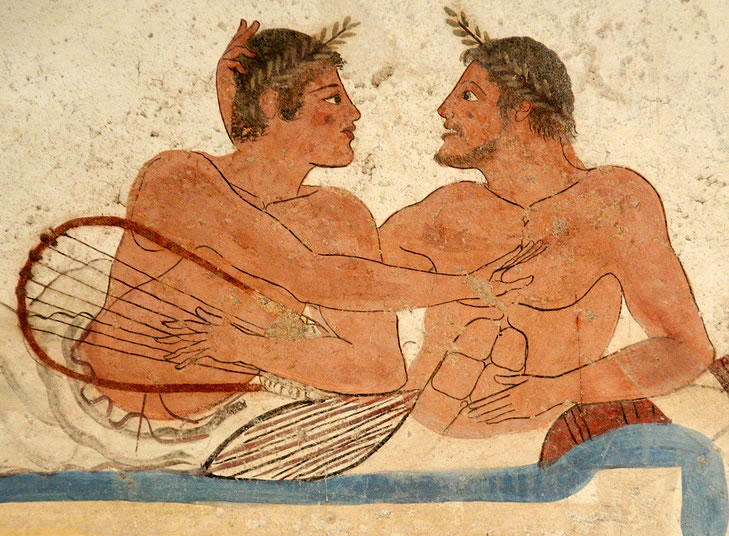In the early 2nd century CE, the Roman Empire was at the height of its power and influence, with vast territories stretching from Europe to Africa and the Middle East. At the center of this sprawling empire was Emperor Hadrian, a man known for his military prowess, intellectual curiosity, and passionate devotion to one particular individual – his lover, Antinous.
Puglia has a history steeped in love. In its early history Puglia was part of Magna Grecia, a group of ancient Greek colonies that were established in Southern Italy and Sicily around the 8th century BCE. The Greek influence in Puglia can be seen in the region’s art, architecture, language, and cuisine, which have been shaped by centuries of cultural exchange and intermingling.
In 272 BC, the Romans expanded throughout the territory conquering Taranto that with the construction of the Via Appia had become an important communication route between Rome and the eastern territories. In Lecce we still see the Roman inheritance with the amphitheaters and, most noticeably, the influence of Roman Emperor Adriano.
Roman Emperor Hadrian’s Love for Antinous: A Story of Ancient Romance and Tragedy

Little is known about Antinous’ early life, but it is believed that he was a young Greek man of humble origins who caught the eye of Emperor Hadrian during his travels in the eastern provinces of the empire. Hadrian was immediately captivated by Antinous’ beauty and intelligence and took him under his wing, eventually elevating him to the status of his beloved companion and confidant.
The relationship between Hadrian and Antinous was a controversial one, not only because of the age difference between the two men (Hadrian was over 40, while Antinous was likely in his late teens or early twenties), but also because of the social and cultural norms of the time, which frowned upon same-sex relationships.
Despite the challenges they faced, Hadrian and Antinous’ love endured, and they traveled together throughout the empire, visiting exotic locales and participating in grand ceremonies and rituals. Antinous was even deified during his lifetime, with Hadrian declaring him a god and commissioning numerous statues and temples in his honor.
Tragically, however, the love story between Hadrian and Antinous was cut short when the young man died under mysterious circumstances while on a journey down the Nile River in 130 CE. The exact cause of Antinous’ death remains unknown, but it is believed that he either drowned or was killed in a ritual sacrifice.
Hadrian was devastated by the loss of his lover and never fully recovered from the grief he felt. He ordered that statues and monuments of Antinous be erected throughout the empire, ensuring that his memory would be preserved for all time. Some have even speculated that Hadrian’s intense love for Antinous played a role in his decision to construct the famous wall in northern Britain that bears his name – a symbol of his desire to create a lasting legacy that would endure for centuries to come.
Today, the story of Hadrian and Antinous remains one of the most enduring and romantic tales of the ancient world, a testament to the power of love and devotion to overcome even the greatest of obstacles.
The cult of Antinous


Marble statue of Antinous from the temple of Apollo at Delphi, 1893. Archaeological Museum of Delphi.
After Antinous’ untimely death, Emperor Hadrian was deeply grief-stricken and sought to honor his memory in a significant way. To accomplish this, Hadrian declared Antinous a god, and established a new cult dedicated to his worship.
This process of deification was not unusual in the ancient world, as many emperors and rulers sought to elevate their loved ones or predecessors to the status of divinity as a means of immortalizing their memory and consolidating their own power.
In Antinous’ case, Hadrian used his political and religious influence to spread the cult of Antinous throughout the empire, commissioning numerous temples, statues, and inscriptions in his honor. He also established an annual festival in Antinous’ name, known as the Antinoeia, which was celebrated throughout the empire with feasts, games, and other forms of entertainment.
The cult of Antinous continued to thrive long after Hadrian’s death, with many devotees continuing to honor and worship the young man as a god well into the late antiquity period. However, with the rise of Christianity and the spread of monotheism, the cult of Antinous gradually fell out of favor and was eventually suppressed, with many of his temples and statues destroyed or repurposed for other uses.
Today, the legacy of Antinous’ deification and worship continues to fascinate scholars and historians, serving as a powerful example of the ways in which love, devotion, and religious faith can shape the course of human history.
